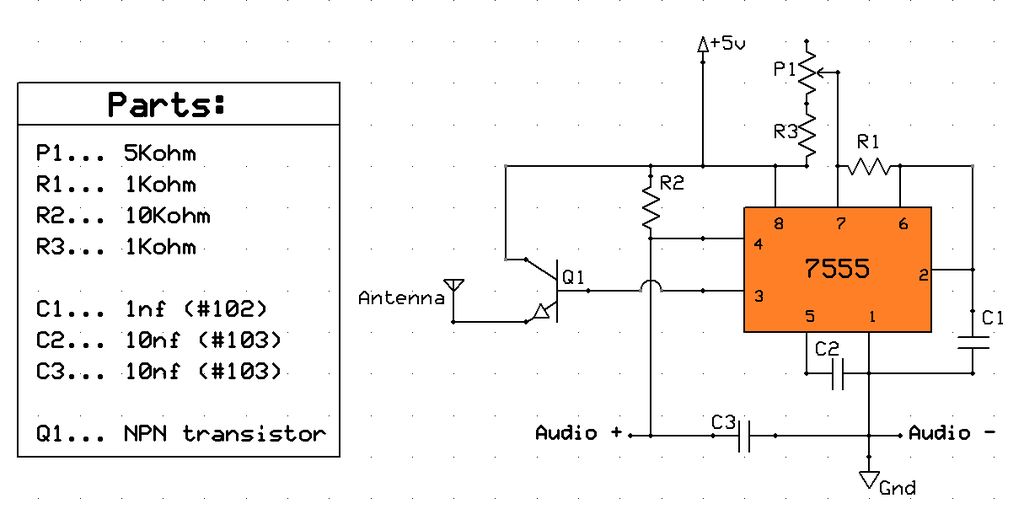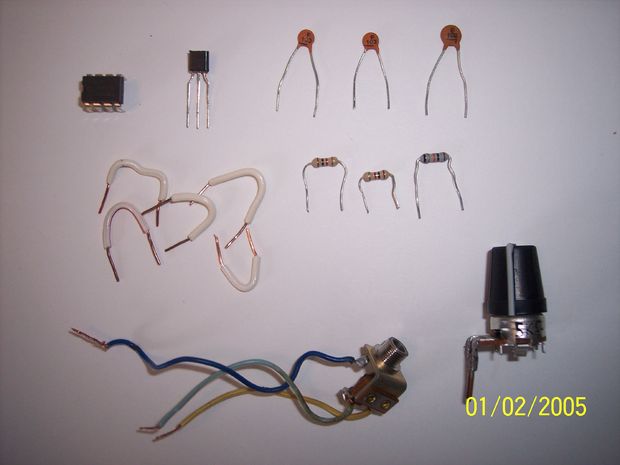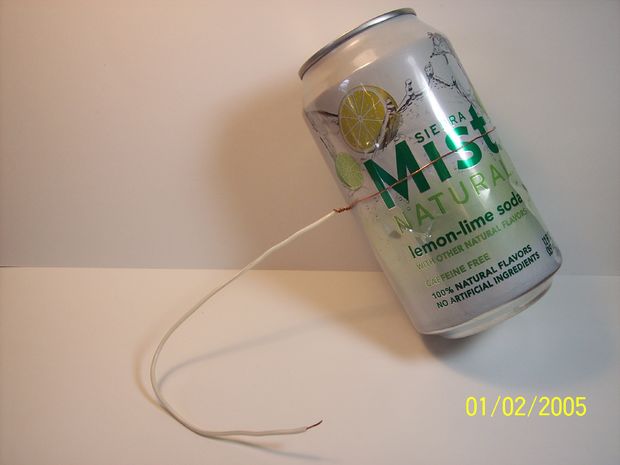| |
AM Radio Transmitter Using 555 Chip |
|
This project shows how to build a simple AM radio transmitter based on 555 timer IC. The circuit parts are: the 555 timer IC, a NPN transistor three caps, three resistors and a potentiometer. The circuit is able to generate an amplitude modulation signal at 600Khz and you are able to receive it using a plain AM receiver. The range is about 30-40 feet.

You are going to build an AM radio transmitter AND you will be shown how it works. When you finish your radio, it will look something like mine in the picture above.
These are the components you will need
- 555 timer chip
- NPN transistor
- two #103 capacitors (0.01 microfarads or 10,000 picofarads)
- #102 capacitor (0.001 microfarads or 1,000 picofarads)
- some short wires
- two 1 Kilohm resistors
- 10 Kilohm resistor
- 1/8 inch (3.5 millimeter) female audio jack (yours may have more or less than three wires, but it must have at least two)
- 5 Kilohm potentiometer
- 1/8 inch (3.5 millimeter) male audio cable
- AM radio receiver
- Antenna. Yours doesn't have to be made out of a pop can, but the pop can works
- Breadboard
Test your radio!
To test the AM radio transmitter, simply set the antenna next to your AM radio receiver (Alarm clock) tuned to approximately 600 KHz. Then play with the potentiometer until you can hear your music on your radio. The frequency generated by this devise will be anywhere from 100-480 Kilohertz if you used all the correct component values.
If you hear weird sounds when you turn the potentiometer (and do not hear the audio signal) That means that your radio is working, but your audio signal needs to be configured. try turning the volumed of your audio signal up.
Not working?
~Is there power applied to your transmitter?
~Is the audio signal on?
~try turning the potentiometer.
~try turning up the audio signal
So how does this work?
The audio signal is controlling when the radio signal is being transmitted using its amplitude. this is called amplitude modulation (hence A.M. Radio) (See picture above).
However, as kr.baker pointed out in the comments, "The audio is "modulating" the RESET pin on the 7555. This means that the signal is turning the carrier completely on or off, as opposed to linear amplitude modulation. Consequently, the audio will be distorted." He raises a very good point that I hadn't given much or any thought to. You aren't modulating signals like they normally would be modulated. The audio quality will be greatly distorted because of this lack of having "linear amplitude modulation" - kr.baker
YOU AREN'T TRANSMITTING AM RADIO FREQUENCIES
You are transmitting at a low frequency that can be heard at higher AM frequencies. Lets say I transmit music at a base frequency of 300 Kilohertz (KHz) This music can be heard at the frequencies of 300 KHz, 600 KHz, 900 KHz, 1200 KHz,... (etc.) This is called harmonics. When the radio receiver's picks up a 300 KHz signal on a 2400 KHz band, the signal is heard only faintly. If you were to pick the very same 300 KHz signal on the 600KHz band, it would be exponentially stronger. This is why harmonics are only useful to a degree.
Modify your radio
I want you to modify your radio and post a comment below that tells us what you did and how it worked! it's that simple!
Although, I do have some suggestions:
Try changing R2 to a 3.3Kohm resistor.
Try cutting C3 out of your circuit.
try connecting the radio antenna to ground through a 1Kohm resistor
The radio transmitter we made can only transmit at frequencies from 110KHz to 480KHz. The AM radio band is from 520KHz to 1610KHz. Harmonics are essential to be able to hear audio signals transmitted from our radio transmitter.




Related Links
Downloads
AM Radio Transmitter Using 555 Chip - Link
|
|
|
| |
Accurate LC Meter
Build your own Accurate LC Meter (Capacitance Inductance Meter) and start making your own coils and inductors. This LC Meter allows to measure incredibly small inductances making it perfect tool for making all types of RF coils and inductors. LC Meter can measure inductances starting from 10nH - 1000nH, 1uH - 1000uH, 1mH - 100mH and capacitances from 0.1pF up to 900nF. The circuit includes an auto ranging as well as reset switch and produces very accurate and stable readings. |
|
PIC Volt Ampere Meter
Volt Ampere Meter measures voltage of 0-70V or 0-500V with 100mV resolution and current consumption 0-10A or more with 10mA resolution. The meter is a perfect addition to any power supply, battery chargers and other electronic projects where voltage and current must be monitored. The meter uses PIC16F876A microcontroller with 16x2 backlighted LCD. |
|
|
|
60MHz Frequency Meter / Counter
Frequency Meter / Counter measures frequency from 10Hz to 60MHz with 10Hz resolution. It is a very useful bench test equipment for testing and finding out the frequency of various devices with unknown frequency such as oscillators, radio receivers, transmitters, function generators, crystals, etc. |
|
1Hz - 2MHz XR2206 Function Generator
1Hz - 2MHz XR2206 Function Generator produces high quality sine, square and triangle waveforms of high-stability and accuracy. The output waveforms can be both amplitude and frequency modulated. Output of 1Hz - 2MHz XR2206 Function Generator can be connected directly to 60MHz Counter for setting precise frequency output. |
|
|
|
BA1404 HI-FI Stereo FM Transmitter
Be "On Air" with your own radio station! BA1404 HI-FI Stereo FM Transmitter broadcasts high quality stereo signal in 88MHz - 108MHz FM band. It can be connected to any type of stereo audio source such as iPod, Computer, Laptop, CD Player, Walkman, Television, Satellite Receiver, Tape Deck or other stereo system to transmit stereo sound with excellent clarity throughout your home, office, yard or camp ground. |
|
USB IO Board
USB IO Board is a tiny spectacular little development board / parallel port replacement featuring PIC18F2455/PIC18F2550 microcontroller. USB IO Board is compatible with Windows / Mac OSX / Linux computers. When attached to Windows IO board will show up as RS232 COM port. You can control 16 individual microcontroller I/O pins by sending simple serial commands. USB IO Board is self-powered by USB port and can provide up to 500mA for electronic projects. USB IO Board is breadboard compatible. |
|
|
|
|
ESR Meter / Capacitance / Inductance / Transistor Tester Kit
ESR Meter kit is an amazing multimeter that measures ESR values, capacitance (100pF - 20,000uF), inductance, resistance (0.1 Ohm - 20 MOhm), tests many different types of transistors such as NPN, PNP, FETs, MOSFETs, Thyristors, SCRs, Triacs and many types of diodes. It also analyzes transistor's characteristics such as voltage and gain. It is an irreplaceable tool for troubleshooting and repairing electronic equipment by determining performance and health of electrolytic capacitors. Unlike other ESR Meters that only measure ESR value this one measures capacitor's ESR value as well as its capacitance all at the same time. |
|
Audiophile Headphone Amplifier Kit
Audiophile headphone amplifier kit includes high quality audio grade components such as Burr Brown OPA2134 opamp, ALPS volume control potentiometer, Ti TLE2426 rail splitter, Ultra-Low ESR 220uF/25V Panasonic FM filtering capacitors, High quality WIMA input and decoupling capacitors and Vishay Dale resistors. 8-DIP machined IC socket allows to swap OPA2134 with many other dual opamp chips such as OPA2132, OPA2227, OPA2228, dual OPA132, OPA627, etc. Headphone amplifier is small enough to fit in Altoids tin box, and thanks to low power consumption may be supplied from a single 9V battery. |
|
|
|
|
|
Arduino Prototype Kit
Arduino Prototype is a spectacular development board fully compatible with Arduino Pro. It's breadboard compatible so it can be plugged into a breadboard for quick prototyping, and it has VCC & GND power pins available on both sides of PCB. It's small, power efficient, yet customizable through onboard 2 x 7 perfboard that can be used for connecting various sensors and connectors. Arduino Prototype uses all standard through-hole components for easy construction, two of which are hidden underneath IC socket. Board features 28-PIN DIP IC socket, user replaceable ATmega328 microcontroller flashed with Arduino bootloader, 16MHz crystal resonator and a reset switch. It has 14 digital input/output pins (0-13) of which 6 can be used as PWM outputs and 6 analog inputs (A0-A5). Arduino sketches are uploaded through any USB-Serial adapter connected to 6-PIN ICSP female header. Board is supplied by 2-5V voltage and may be powered by a battery such as Lithium Ion cell, two AA cells, external power supply or USB power adapter. |
|
200m 4-Channel 433MHz Wireless RF Remote Control
Having the ability to control various appliances inside or outside of your house wirelessly is a huge convenience, and can make your life much easier and fun. RF remote control provides long range of up to 200m / 650ft and can find many uses for controlling different devices, and it works even through the walls. You can control lights, fans, AC system, computer, printer, amplifier, robots, garage door, security systems, motor-driven curtains, motorized window blinds, door locks, sprinklers, motorized projection screens and anything else you can think of. |
|
|
|